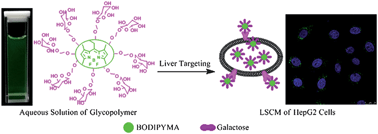In this article, Zhang, Li and co-workers synthesized by Atom Transfer Radical Polymerization (ATRP) a highly water-soluble, multivalent and highly specific BODIPY-conjugated glycopolymer for direct tumor cell imaging, which showed good photostability. The cell viability of BODIPY-conjugated glycopolymers against HepG2 and NIH3T3 cells was more than 80%, indicating that the glycopolymers have low cytotoxicity to living cells. Moreover, simple incubation of living cells with a BODIPY-conjugated glycopolymer led to efficient internalization into HepG2 and clear visualization in cytoplasm, due to the high brightness of BODIPY and good specificity between HepG2 and galactose as compared to NIH3T3 cells. These results suggest that BODIPY-conjugated glycopolymers have potential use as fluorescent probes in live cell imaging.
Water-soluble BODIPY-conjugated glycopolymers as fluorescent probes for live cell imaging by Zhentan Lu, Lin Mei, Xinge Zhang, Yanan Wang, Yu Zhao and Chaoxing Li Polym. Chem. 2013, 4, 5743-5750.
Julien Nicolas is a guest web-writer and advisory board member for Polymer Chemistry. He currently works at Univ. Paris-Sud (FR) as a CNRS researcher.











